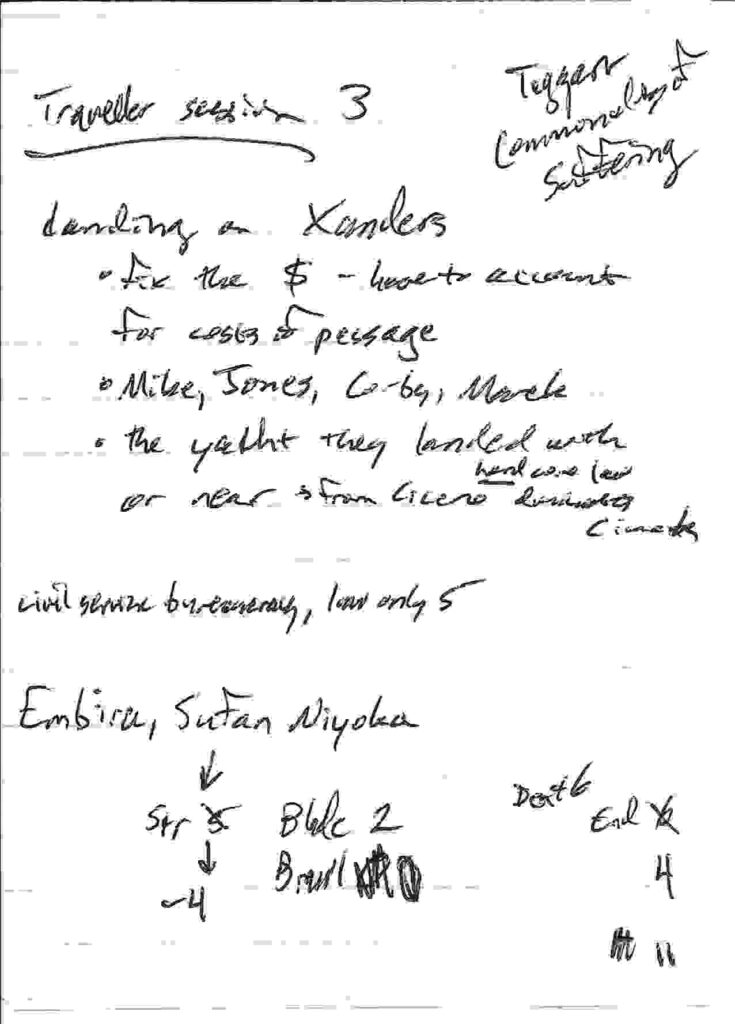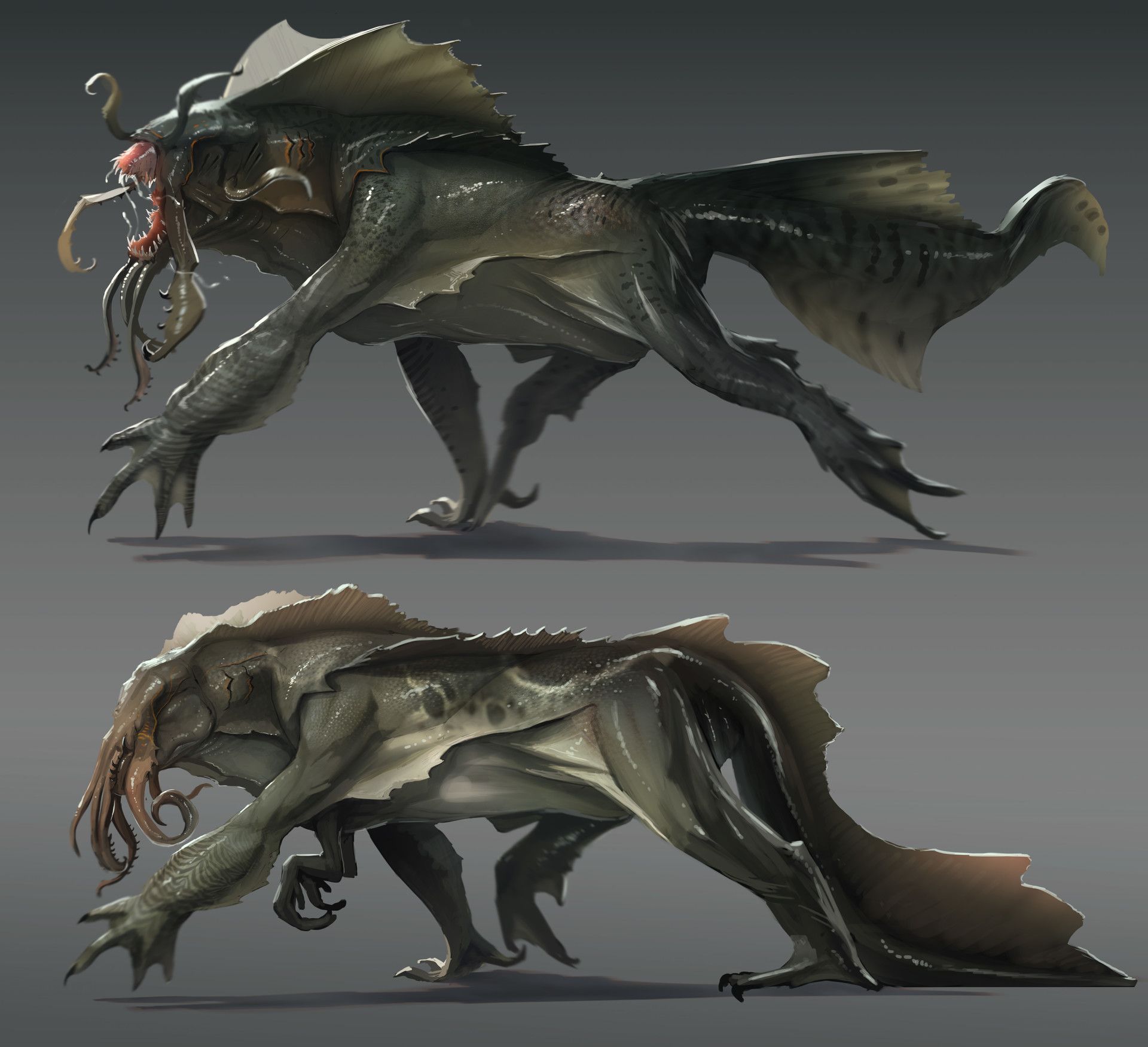Back in June, I played more sessions of original or nigh-original Traveller with Johan and Nathan. It has been one of the most pleasantly educational experiences of play that I can remember.
We have really learned that most principles about “how it’s done” don’t apply to this early text and, I assume, to how the creators were playing it. Things which were later presumed to be automatically turfed to someone judging and saying it are, in this case, rolled instead, and vice versa. Things which were later presumed to be prepared and known, at least by one person, are, in this case, spitballed into place as needed during play, and vice versa.
In my first post about the game, Yonder out yonder, we’d played two sessions, and by then the process of what is our situation had shaken into place. In the third and fourth sessions, we learned or at least grappled with a number of specific subroutines about combat, psionics, and encounters.
Here’s the full information about the sector, including the location of Sheol.
Here are the summaries I compiled just before we started play.
The third and fourth session represented a sharp swerve from the patron-oriented mission. I focused hard on what was exactly at hand in this moment of play: arrival at Xanders, the yacht they’d encountered, the exact social circumstances, and the mystery of Sheol. I’d taken the time to re-read one of the Dumarest of Terra books by E.C. Tubb, which are clearly the main influence on the game.

If you’ve read these (about thirty short novels), you know they are extremely formulaic, almost to the point of self-parody. In this case, and having deliberately reached into the middle of the series, It helped me say, “oh right, these are the standard plot points and presumptions,” and my NPCs Embira, Sofan, and Buis – from the yacht first seen at the end of session 2 – jumped forward easily in my mind. I knew that they had come to the region for sport hunting, that Embira was bored and liked the idea of rubbing shoulders with shady strangers, and that Sofan was ready for a duel for any imaginable provocation. … And that their bodyguard, Buis, was surgically altered, similar to the Cybers in the novels, but for an entirely different purpose related to the mysterious planet Sheol. In other words, I finally arrived at my concept for what the hell we were playing, working from small (people) to big (planets and the sector).

Given my preparation for the hunting in session 4, it’s all about making creatures and encounters. We even got a bit excited about it during the session and deviated into a chat about the dangerous puddle-like herbivore when play didn’t result in an encounter with it, just to appreciate the tables’ interface with a person’s imagination and ecological interpretation. Here are my preparation notes for creature encounters in the open plains by the landing point, in the ruins, and in the crater in the ruins.
I say with some pride that these videos (all four sessions) are the very opposite of a slick, entertaining, see-the-experts pseudo-play video. It won’t impress anyone. We know we’re in the learning curve, and I’ve preserved most of the table-talk and rules-puzzling, so you can see how it really was. Sometimes, all we can manage is to agree about why we’re confused … but also, sometimes we trust the original play which produced this text enough to stay with our confusion, and to reach understanding just by trying it.
Some points and lessons learned:
- I don’t think we ever absolutely understood combat injury, which unlike most of the text didn’t illuminate itself through use it; it was especially a mess during the duel in session 3, but we decided how to do it (rightly or wrongly) for the animal encounters in session 4. In later play of this game, some day, I’ll set this topic as a deliberate goal.
- Quit looking for skill checks and run anything that’s not a skill directly off the attribute scores, e.g., “how educated are you.”
- Work directly off rolled results regarding any aspect of the situation, including composition, distance, and reaction rolls … but which also requires solid notions of where the characters actually are, where they are going, and what they are trying to do. Those notions come from the sociological and ecological details of the planet and whatever region you’re in, but also from plain old play-statements intersecting among GM and player authorities.
As it happened, I think all of us were enjoying play enough to continue, but it was just the three of us, begun at a moment when most participants in Adept Play at Spelens Hus were out of town, and at this point, we were using up a time-slot that really needed to expand. We also talked about whether to include returning people into play, but the very learning curve we were enjoying was so mutual, with all of us reading the text and with no one person leading the process, that we couldn’t face bringing people in and starting over. That’s why the end of session 4 includes some discussion about my larger preparation and my reasoning for it, as we knew with some regret that we wouldn’t be continuing.


2 responses to “Keeps on giving”
This was fun to watch, and I especially enjoyed the sense of discovery as you talked through the consequences of being wounded and the vivid situational changes it led to. That and similar moments really piqued my interest in playing the game.
I was surprised at how minor the concept of small-business management is. Yes, the characters might be in debt or in some kind of economic crunch, but they don’t have to be. And the many play-mechanisms like patronage, encounters with rich people, and the economics of perfectly legitimate hauling and trade would turn it into merely a feature, not the center of play. Play as instructed and provided for in the text is much more about an unexpected crisis arising from sociology and ecology.